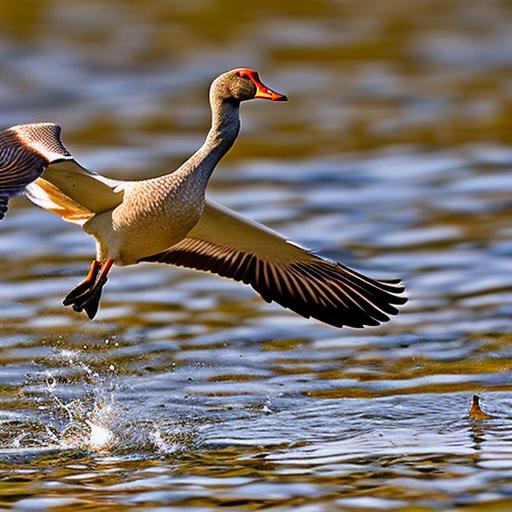Cross breeding geese can offer a wide range of benefits for farmers and breeders. One of the main advantages of cross breeding is the potential for hybrid vigor, which can result in healthier and more robust offspring. By combining the genetic traits of different breeds, cross bred geese may exhibit increased resistance to diseases, improved growth rates, and better overall performance. Additionally, cross breeding can also lead to a wider range of desirable traits, such as different feather colors, sizes, and temperaments, which can be appealing to consumers. Furthermore, cross breeding can help to preserve genetic diversity within the goose population, which is important for the long-term sustainability of the breed.
Another benefit of cross breeding geese is the potential for improved productivity and efficiency. By carefully selecting breeds with complementary traits, farmers can create cross bred geese that are well-suited to their specific production goals. For example, by crossing breeds known for their high egg production with breeds known for their meat quality, farmers can create geese that are dual-purpose and can provide both eggs and meat. This can help to maximize the economic potential of the geese and increase the overall profitability of the breeding operation.
Selecting the Right Breeds for Cross Breeding
When it comes to cross breeding geese, selecting the right breeds is crucial for achieving the desired results. The first step in selecting breeds for cross breeding is to clearly define the breeding goals and objectives. This may include determining whether the primary focus is on meat production, egg production, or dual-purpose traits. Once the breeding goals are established, farmers can then begin to research and identify breeds that possess the desired traits. It is important to consider the specific characteristics of each breed, such as size, color, temperament, and productivity, and to select breeds that complement each other well.
In addition to considering the physical and performance traits of the breeds, it is also important to take into account the genetic diversity of the breeds. By selecting breeds that are genetically distinct from each other, farmers can maximize the potential for hybrid vigor and avoid inbreeding depression. Furthermore, it is important to choose breeds that are well-suited to the local climate and environmental conditions, as this can help to ensure the health and well-being of the cross bred geese. Overall, the selection of breeds for cross breeding should be a thoughtful and well-researched process that takes into consideration both the short-term and long-term breeding goals.
Creating a Suitable Environment for Cross Breeding
Creating a suitable environment for cross breeding geese is essential for the success of the breeding program. The first step in creating a suitable environment is to provide adequate housing and nesting facilities for the geese. This may include providing spacious and well-ventilated housing that is protected from predators and the elements. Additionally, it is important to provide nesting boxes or areas where the geese can lay and incubate their eggs in a safe and comfortable environment. By providing suitable housing and nesting facilities, farmers can help to ensure the health and well-being of the geese and increase the likelihood of successful breeding.
In addition to providing suitable housing, it is also important to create a suitable feeding and nutrition program for the geese. Proper nutrition is essential for the health and fertility of the geese, and it is important to provide a balanced diet that meets the specific nutritional needs of the breeding geese. This may include providing a high-quality commercial feed, as well as access to fresh water and foraging opportunities. By providing a suitable feeding and nutrition program, farmers can help to ensure that the geese are in optimal breeding condition and can produce healthy offspring.
Managing the Breeding Process
Managing the breeding process is a critical aspect of cross breeding geese, and it requires careful planning and attention to detail. One of the first steps in managing the breeding process is to establish a breeding schedule and timeline. This may include determining the optimal breeding season for the geese, as well as the specific breeding pairs that will be used. By establishing a breeding schedule, farmers can help to ensure that the geese are bred at the most opportune times and that the breeding pairs are well-matched.
In addition to establishing a breeding schedule, it is also important to closely monitor the breeding pairs and their behavior. This may include observing the mating behavior of the geese, as well as monitoring the laying and incubation of the eggs. By closely monitoring the breeding pairs, farmers can identify any potential issues or challenges that may arise and take proactive measures to address them. Furthermore, it is important to provide the breeding pairs with a calm and stress-free environment, as this can help to promote successful breeding and improve the overall fertility of the geese.
Ensuring the Health and Well-being of Cross Bred Geese
Ensuring the health and well-being of cross bred geese is essential for the success of the breeding program and the overall productivity of the geese. One of the first steps in ensuring the health and well-being of the geese is to provide regular veterinary care and health monitoring. This may include scheduling regular check-ups with a qualified avian veterinarian, as well as monitoring the overall health and condition of the geese on a daily basis. By providing regular veterinary care and health monitoring, farmers can help to identify and address any potential health issues before they become more serious.
In addition to providing regular veterinary care, it is also important to implement a comprehensive biosecurity program to prevent the spread of diseases and pathogens. This may include implementing strict biosecurity protocols, such as limiting the movement of people and equipment in and out of the goose facilities, as well as regularly disinfecting the facilities and equipment. By implementing a comprehensive biosecurity program, farmers can help to minimize the risk of disease outbreaks and protect the health of the geese. Furthermore, it is important to provide the geese with a clean and sanitary living environment, as this can help to prevent the spread of diseases and improve the overall health and well-being of the geese.
Maximizing the Productivity of Cross Bred Geese
Maximizing the productivity of cross bred geese is a key goal for many farmers and breeders, and it requires careful management and attention to detail. One of the first steps in maximizing productivity is to implement a comprehensive breeding program that is focused on achieving specific production goals. This may include selecting breeds with complementary traits, as well as carefully managing the breeding pairs and monitoring the breeding process. By implementing a comprehensive breeding program, farmers can help to ensure that the geese are well-suited to their specific production goals and can produce offspring that meet the desired criteria.
In addition to implementing a comprehensive breeding program, it is also important to provide the geese with a high-quality diet and nutrition program that meets their specific needs. This may include providing a balanced commercial feed, as well as access to fresh water and foraging opportunities. By providing a high-quality diet and nutrition program, farmers can help to ensure that the geese are in optimal breeding condition and can produce healthy offspring. Furthermore, it is important to provide the geese with a suitable living environment that is clean, spacious, and well-ventilated, as this can help to reduce stress and promote successful breeding.
Addressing Challenges in Cross Breeding Geese
While cross breeding geese can offer a wide range of benefits, it is important to be aware of the potential challenges and obstacles that may arise. One of the main challenges in cross breeding geese is the potential for inbreeding depression, which can occur when closely related breeds are crossed. Inbreeding depression can lead to reduced fertility, increased susceptibility to diseases, and decreased overall performance. To address this challenge, it is important to carefully select breeds that are genetically distinct from each other and to avoid breeding closely related individuals. By selecting breeds with a high level of genetic diversity, farmers can help to minimize the risk of inbreeding depression and improve the overall health and productivity of the geese.
Another challenge in cross breeding geese is the potential for genetic drift, which can occur when the genetic traits of the breeds become diluted over time. Genetic drift can lead to a loss of desirable traits and a decrease in overall productivity. To address this challenge, it is important to carefully manage the breeding program and to regularly evaluate the genetic traits of the offspring. This may include periodically introducing new breeds into the breeding program to maintain genetic diversity and to preserve desirable traits. By carefully managing the breeding program and monitoring the genetic traits of the offspring, farmers can help to minimize the risk of genetic drift and maintain the overall productivity of the geese.
Utilizing Cross Bred Geese for Different Purposes
Cross bred geese can be utilized for a wide range of purposes, including meat production, egg production, and ornamental purposes. One of the main advantages of cross bred geese is their potential for dual-purpose traits, which can allow them to provide both meat and eggs. By carefully selecting breeds with complementary traits, farmers can create cross bred geese that are well-suited to their specific production goals. For example, by crossing breeds known for their high egg production with breeds known for their meat quality, farmers can create geese that are dual-purpose and can provide both eggs and meat. This can help to maximize the economic potential of the geese and increase the overall profitability of the breeding operation.
In addition to meat and egg production, cross bred geese can also be utilized for ornamental purposes, such as for exhibition or as pets. Cross breeding can lead to a wider range of desirable traits, such as different feather colors, sizes, and temperaments, which can be appealing to consumers. By carefully selecting breeds with unique and attractive traits, farmers can create cross bred geese that are well-suited for ornamental purposes. This can help to diversify the market potential of the geese and appeal to a wider range of consumers.
Marketing and Selling Cross Bred Geese
Marketing and selling cross bred geese requires careful planning and a thorough understanding of the target market. One of the first steps in marketing and selling cross bred geese is to clearly define the target market and the specific needs and preferences of the consumers. This may include conducting market research to identify the demand for cross bred geese, as well as the specific traits and characteristics that are most desirable to consumers. By understanding the needs and preferences of the target market, farmers can develop a marketing strategy that effectively promotes the unique traits and benefits of the cross bred geese.
In addition to understanding the target market, it is also important to develop a strong brand and reputation for the cross bred geese. This may include establishing a recognizable brand name and logo, as well as promoting the unique traits and benefits of the geese through various marketing channels. By developing a strong brand and reputation, farmers can help to differentiate their cross bred geese from the competition and appeal to a wider range of consumers. Furthermore, it is important to provide excellent customer service and support to consumers, as this can help to build trust and loyalty and encourage repeat purchases.
Future Trends in Cross Breeding Geese
The future of cross breeding geese is likely to be influenced by a wide range of trends and developments in the agricultural industry. One of the main trends in cross breeding geese is the increasing demand for sustainable and environmentally-friendly production practices. As consumers become more conscious of the environmental impact of their food choices, there is a growing demand for geese that are raised using sustainable and ethical practices. This may include implementing organic and pasture-based production systems, as well as reducing the use of antibiotics and chemicals. By embracing sustainable production practices, farmers can help to meet the growing demand for environmentally-friendly geese and appeal to a wider range of consumers.
Another trend in cross breeding geese is the increasing interest in rare and heritage breeds. As consumers become more interested in unique and traditional food products, there is a growing demand for geese that are raised using rare and heritage breeds. This may include promoting the unique traits and characteristics of rare and heritage breeds, as well as preserving genetic diversity within the goose population. By embracing rare and heritage breeds, farmers can help to meet the growing demand for unique and traditional geese and appeal to a niche market of consumers.
In conclusion, cross breeding geese can offer a wide range of benefits for farmers and breeders, including improved productivity, genetic diversity, and market potential. By carefully selecting breeds, creating a suitable environment, managing the breeding process, and ensuring the health and well-being of the geese, farmers can maximize the potential of cross breeding and create geese that are well-suited to their specific production goals. Additionally, by addressing challenges, utilizing the geese for different purposes, and effectively marketing and selling the geese, farmers can capitalize on the unique traits and benefits of cross bred geese. Looking to the future, the trends in sustainable production practices and rare and heritage breeds are likely to influence the future of cross breeding geese and provide new opportunities for farmers and breeders. Overall, cross breeding geese has the potential to play a significant role in the future of the agricultural industry and provide a sustainable and profitable source of meat, eggs, and ornamental products.
Meet Walter, the feathered-friend fanatic of Florida! Nestled in the sunshine state, Walter struts through life with his feathered companions, clucking his way to happiness. With a coop that’s fancier than a five-star hotel, he’s the Don Juan of the chicken world. When he’s not teaching his hens to do the cha-cha, you’ll find him in a heated debate with his prized rooster, Sir Clucks-a-Lot. Walter’s poultry passion is no yolk; he’s the sunny-side-up guy you never knew you needed in your flock of friends!







